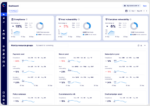
The advantages of cloud computing have proven themselves in business practices. What organization wouldn’t want to lower capital expenditures and realize greater elasticity to grow its business? The benefits are many and companies have adopted accordingly.
The RightScale 2019 State of the Cloud report from Flexera showed 94 percent of respondents rely on the cloud, illustrating that it’s a rare enterprise that doesn’t have at least some computing workloads in the cloud. Since 2017, Microsoft has derived more revenues from its cloud-hosted Office 365 suite than its traditional Microsoft Office licensing business. Tech conglomerate Cisco has predicted that by 2021, 94 percent of all workloads will be cloud-based.
To support the digital transformation enabled by cloud computing, cloud providers have differentiated their software stacks and available APIs. IT departments and service providers are increasingly being asked to migrate workloads from one cloud instance to another. Yet doing so can present its own unique hurdles.
Migration Strategies
When embarking on any migration project, critical business operations are often involved. IT teams and service providers are challenged to maintain continuous user productivity throughout the process. An increasingly common scenario is moving all or a subset of users from one instance of Office 365 to another. Migrating one instance of a workload in the cloud to another instance of the same workload in a different cloud environment is referred to as a tenant-to-tenant (T2T) migration. In order to minimize the disruption, the IT staff or service provider typically singles out the most time-sensitive items or those that are relied upon most by the users. This allows IT staff to complete the most critical portions of the migration within the shortest possible time window. The team migrates in batches any older email files or archived data that’s less likely to be needed either before or after moving the critical items.
No matter how carefully planned the migration, there is still the possibility that a user on the Source who hasn’t yet been migrated will attempt to send an email or meeting invite to another user who already has been migrated to the Destination, or vice versa. The result? Emails sent to mailboxes that are no longer being checked, bounced messages, missed meeting invitations, or double-bookings due to free/busy information that can be accessed in two different environments.
Why Coexistence?
Coexistence allows a user to have an email account in two separate Office 365 instances at the same time while maintaining seamless communication. Coexistence is possible when the two Office 365 instances have different domain names, for example when migrating user@thiscompany.com to user@thatcompany.com. IT pros and service providers frequently encounter this scenario. When one company is sold or merges with another company, it creates a situation where groups of users need to be migrated between different domains.
When implemented, coexistence allows the consistent delivery of emails and calendar information regardless of the state of the migration and whether or not a user has been migrated. The organization maintains productivity throughout the process, eliminating interference issues for users. The IT staff is able to realize the ultimate goal of any migration — to make the process smooth and unobtrusive to end users.
To apply coexistence, first, prepare for the migration:
- Make sure that organizational sharing is enabled in both instances of Office 365.
- For each user to be migrated, create a mail-enabled contact on the Destination that points back to the corresponding individual’s mailbox on the Source. This allows users to continue working in the Source mailbox up until the time their individual account has been migrated, while receiving email and calendar invites sent to either address.
Then, as you migrate each user:
- Remove the user’s mail-enabled contact from the Destination, replace it with an Office 365-licensed user account, and set a forward that points back to the Source mailbox so the user can keep working.
- Now, migrate the email items from the Source mailbox to the Destination.
- Remove the forward from the Destination mailbox. The user can now log in to the new mailbox, which is configured and populated with the same emails as before. The new domain name and password prompt are the only indication to the user that anything has changed.
- Finally, deal with the Source mailbox. Remove it and add a mail-enabled contact that resolves to the Destination. Alternatively, if there’s a reason to keep the old mailbox, simply add a forward that points to the Destination.
For organizations adopting new cloud technologies and taking on a T2T migration, coexistence enables a truly seamless switchover. With the proper planning, you’ll pull off the smoothest migration possible.








